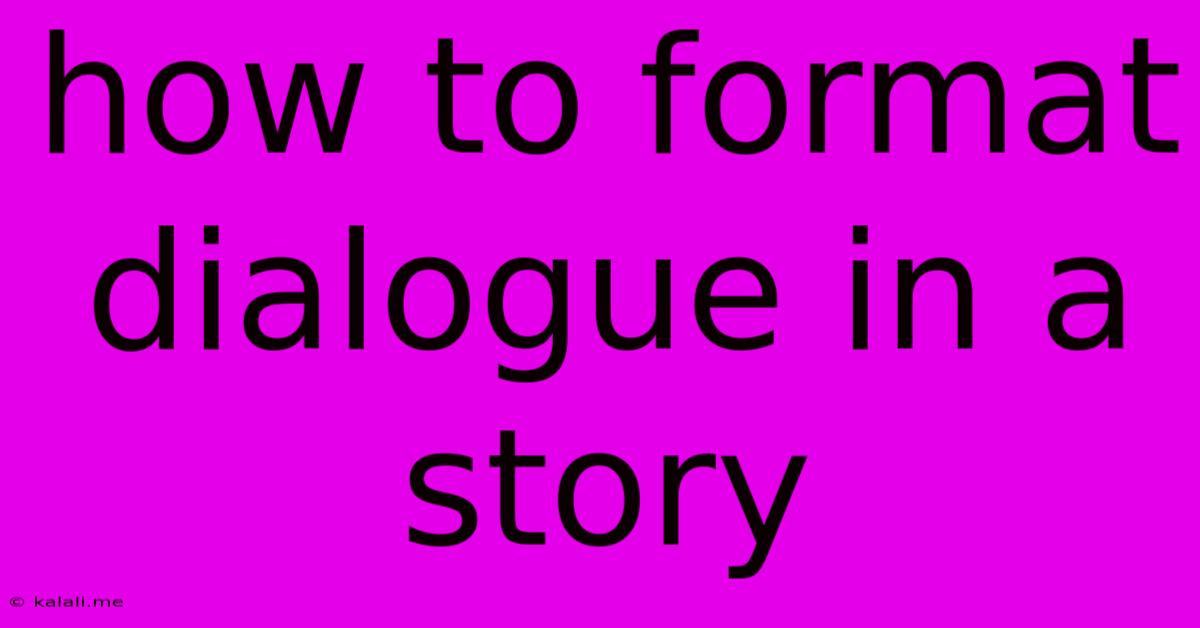How To Format Dialogue In A Story
Kalali
Jun 11, 2025 · 3 min read

Table of Contents
How to Format Dialogue in a Story: A Guide for Writers
This comprehensive guide will equip you with the knowledge to effectively format dialogue in your stories, ensuring clarity, readability, and a professional polish. Mastering dialogue formatting elevates your writing, enhancing the reader's experience and making your storytelling more impactful. This article covers everything from basic punctuation to advanced techniques for handling multiple speakers and complex conversations.
Why Proper Dialogue Formatting Matters
Proper dialogue formatting isn't just about aesthetics; it's crucial for clarity and readability. Poorly formatted dialogue can confuse readers, interrupting the flow of your narrative and hindering their engagement with your story. By mastering these techniques, you'll create a smoother, more professional reading experience that keeps your audience captivated.
The Fundamentals of Dialogue Formatting
- Quotation Marks: Use quotation marks (" ") to enclose each speaker's words. Consistency is key – stick to either double or single quotation marks throughout your manuscript, but maintain consistency.
- Paragraph Breaks: Start a new paragraph each time the speaker changes. This clearly signals a shift in who's talking. Even short exchanges between characters warrant separate paragraphs.
- Punctuation: Commas and periods always go inside the closing quotation marks. Question marks and exclamation points go inside if they're part of the dialogue; otherwise, they go outside.
Example:
"I'm going to the store," she said. "Do you need anything?"
"Yes," he replied. "Could you grab some milk?"
Handling Multiple Speakers
When multiple characters are involved in a conversation, clear paragraph breaks are essential. Each new paragraph indicates a change in speaker.
Example:
"The meeting is at 2 PM," she announced.
"But I have a dentist appointment then," John protested.
"We can reschedule," she said patiently. "It's important we all attend."
Attribution:
- Attribution placement: Typically, attribution (e.g., "he said," "she whispered") goes after the spoken words, followed by a comma. However, you can also place it before the quote, especially for short, impactful statements.
- Variety in attribution: Avoid overusing "said." Explore alternatives like asked, replied, whispered, shouted, murmured, exclaimed. This adds richness and nuance to your writing.
Example:
"I'm leaving," she said abruptly.
He asked, "Where are you going?"
Dialogue Tags and Action Beats:
- Dialogue tags: These words (like "said," "whispered," etc.) indicate who is speaking. Use them sparingly; let the context and character's actions reveal the emotion rather than relying heavily on tags.
- Action beats: Integrate brief descriptions of actions or expressions into your dialogue to break up long stretches of speech and reveal character emotions.
Example:
"I'm not sure about this," she said, nervously twisting a strand of hair.
Formatting Dialogue with Interruptions:
When one speaker interrupts another, use an em dash (—) to indicate the interruption.
Example:
"I think we should—"
"No, we shouldn't! It's too risky!"
Advanced Techniques:
- Internal monologue: Use italics to distinguish a character's thoughts from their spoken words.
- Silence: Use ellipses (...) to depict pauses or silences in a conversation. This creates suspense and allows the reader to infer unspoken emotions.
- Non-standard dialogue: Consider using dialect or unique speech patterns to develop distinct character voices, but use sparingly to avoid confusing the reader.
By incorporating these guidelines, you can seamlessly integrate dialogue into your narrative, creating a dynamic and engaging reading experience. Remember, the goal is to make the conversation feel natural and authentic, while maintaining clarity and readability. Mastering these techniques will significantly improve the quality and professionalism of your storytelling.
Latest Posts
Latest Posts
-
What Is The Biggest Ecosystem On Earth
Jun 12, 2025
-
Isotopes Are Atoms That Have
Jun 12, 2025
-
How To Calculate Modulus Of Resilience
Jun 12, 2025
-
This Body Of Water Divides Europe And North Africa
Jun 12, 2025
-
New York University Average Sat Score
Jun 12, 2025
Related Post
Thank you for visiting our website which covers about How To Format Dialogue In A Story . We hope the information provided has been useful to you. Feel free to contact us if you have any questions or need further assistance. See you next time and don't miss to bookmark.